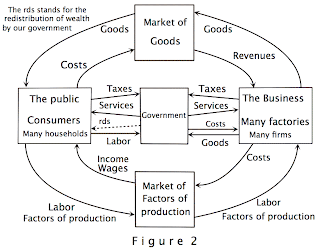Macroeconomics
(from Greek prefix "makros-" meaning "large" + "economics") is a branch
of economics dealing with the performance, structure, behavior, and
decision-making of the whole economy. This includes national, regional,
and global economies. With microeconomics, macroeconomics is one of the two most general fields in economics.
Macroeconomists study aggregated indicators such as GDP, unemployment rates, and price indices to understand how the whole economy functions.
Macroeconomists develop models that explain the relationship between such factors as national income, output, consumption, unemployment, inflation, savings, investment, international trade and international finance. In contrast, microeconomics is primarily focused on the actions of individual agents, such as firms and consumers, and how their behavior determines prices and quantities in specific markets. While macroeconomics is a broad field of study, there are two areas of research that are emblematic of the discipline: the attempt to understand the causes and consequences of short-run fluctuations in national income (the business cycle), and the attempt to understand the determinants of long-run economic growth (increases in national income). Macroeconomic models and their forecasts are used by both governments and large corporations to assist in the development and evaluation of economic policy and business strategy.
Macroeconomists study aggregated indicators such as GDP, unemployment rates, and price indices to understand how the whole economy functions.
Macroeconomists develop models that explain the relationship between such factors as national income, output, consumption, unemployment, inflation, savings, investment, international trade and international finance. In contrast, microeconomics is primarily focused on the actions of individual agents, such as firms and consumers, and how their behavior determines prices and quantities in specific markets. While macroeconomics is a broad field of study, there are two areas of research that are emblematic of the discipline: the attempt to understand the causes and consequences of short-run fluctuations in national income (the business cycle), and the attempt to understand the determinants of long-run economic growth (increases in national income). Macroeconomic models and their forecasts are used by both governments and large corporations to assist in the development and evaluation of economic policy and business strategy.



No comments:
Post a Comment